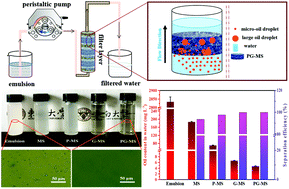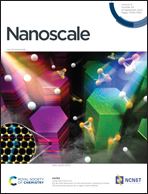Superhydrophobic graphene-coated sponge with microcavities for high efficiency oil-in-water emulsion separation†
Abstract
Materials for emulsion separation with low pressure, high flux and high stability are of great interest in the treatment of oily wastewater. Herein, we report a facile strategy for the fabrication of PDMS and graphene coated melamine sponge (PG-MS), which can efficiently separate oil-in-water emulsions. In PG-MS, melamine sponge (MS) provides a three-dimensional porous structure, graphene constructs hydrophobic microcavities, and PDMS enhances the hydrophobic property of the material, forming a superhydrophobic material. The PG-MS shows high flux (experimentally 10 000 L m−2 h−1, and the effective flux increases with the thickness of the filter layer), high separation efficiency (oil content of the filtered water ∼4.7 mg L−1 can be discharged directly, with oil separation efficiency >99%), low pressure (applied to overcome water's gravity), and high stability (no obvious change in 20 cycles). Our study indicates that PG-MS has a wide range of applications in oil-in-water emulsion separation in industry and environmental sciences.

- This article is part of the themed collection: Chemistry of 2D materials: graphene and beyond


 Please wait while we load your content...
Please wait while we load your content...